 |
American History
Mary of Agreda in America - Part V
Who Was Mother Mary of Agreda?
Margaret C. Galitzin
To end this series on the miraculous bilocations of Ven. Mary of Agreda, I thought the reader would like to know more about her. Who was the cloistered Spanish nun who bilocated to the American Southwest in the 17th century to instruct the Indians in the Catholic Faith and prepare them for baptism? This short biography will answer that question.
She was born Maria Coronel y Arana on April 2, 1602 in the town of Agreda in the Province of Soria in north Spain to Francisco Coronel and Catalina de Arana, a family of noble lineage but reduced means. The pious couple had 11 children, but only four lived to adulthood: Francis, Joseph, Mary and Jeronima. The children – and also their parents – would all become religious in the family of St. Francis.
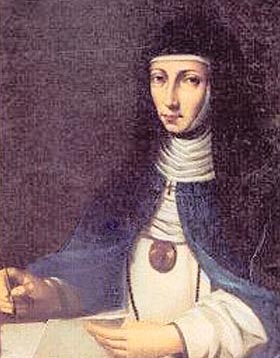
Mother Mary of Jesus (1602-1665) |
From childhood, she was favored by God with ecstasies and visions. She took a vow of chastity at age eight, and four years later requested her parents’ permission to enter a nearby Carmelite convent. That course changed, however, after her mother had a vision in which Our Lord revealed to her His desire that she should form a convent in her own home.
After overcoming many difficulties, in January of 1618, the mother and her two daughters took the habit in their family home, which became the Franciscan Convent of the Immaculate Conception. On the same day, her father became a monk in the Order of St. Francis, where his two sons were already religious.
Eight years later, at the age of 25 and with a papal approval, Mary of Jesus was made Abbess, a burden she reluctantly took on her young shoulders. She would continue to govern the Agreda Convent – except for one brief period – until her death in 1665.
At the beginning of The Mystical City of God, she wrote:
“The Almighty in His sheer goodness favored our family so much that all of us were consecrated to Him in the religious state. In the eighth year of the foundation of this convent, in the 25th year of my life, in the year of Our Lord 1627, holy obedience imposed upon me the office of Abbess, which to this day I unworthily hold.” (1)
Two investigations and words of praise
As news spread about the visions and writings of the holy Abbess, the attention of the Spanish Inquisition turned in her direction. In 1635 – shortly after the first visit of Fr. Alonso de Benavides to her Convent (see Part II) – a first inquiry was held. The majority of the questions were about her bilocations to America. Her inquisitors found her blameless and praised her virtue, charity and intelligence.
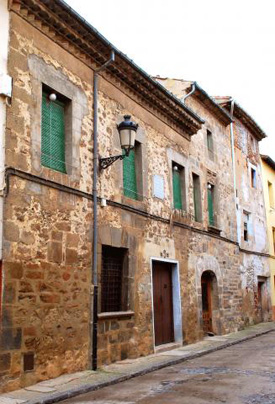
The family house became the first convent |
In January of 1650, a second investigation opened. Inquisitors came to the Agreda Convent and questioned Mother Mary of Jesus for 11 days with 80 questions, which covered her bilocations, her writings and also the erroneous information that she was involved in a plot against the Spanish King. The case closed with Mary of Agreda exonerated of all suspicion. Again, the Inquisitors eulogized her life of prayer and her fidelity to Holy Mother Church.
Throughout her life, Mary of Jesus would affirm that obedience was her “compass” in life. She always opened her soul to her spiritual directors, manifesting the grace and favors received from Our Lord and asking for their approbation and counsel.
We know the names of her various directors because of the Inquisition records: They were Fr. Juan de Torrecilla, Fr. Juan Bautista de Santa María y Fr. Tomás Gonzalo. By the order of the Provincial, Fr. Francisco Andrés de la Torre would direct her from 1623 to 1647, when he died. Some difficult years passed for Mother Mary of Jesus under temporary spiritual directors until finally, in 1655 Fr. Andrés de Fuenmayor assumed her direction and continued until her death in 1665.
We have a vivid example of her spirit of ready obedience in the redaction of her most famous and controversial work, The Mystical City of God, a life of the Blessed Virgin dictated to the Conceptionist nun by the Heavenly Queen herself. In 1643, under the order of Fr. de la Torre, she wrote the massive work in her own hand. During his absence, however, a temporary director instructed her to burn that manuscript and the rest of her writings. She readily complied.
When Fr. de la Torre returned, he reprimanded her sharply and commanded her to begin again. When he died in 1647, another order from another temporary director came to destroy the manuscript. A second time it was burned.
Finally, her last and most trusted director, Fr. de Fuenmayor ordered Mary of Agreda to take up her pen for the third time. In 1655, she completed the magnificent work we have today on the life of the Virgin Mary. The same Fr. Fuenmayor wrote her first biography and testified under oath to her life of virtue and holiness at the process of beatification that opened seven years after her death.
A long correspondence with the King
In 1642 Maria of Jesus sent King Philip IV an account of one of her visions, in which she saw a council of devils plotting to destroy Catholicism and Spain. The King, who had already read Fr. Benavides’ Memorial of her mystical bilocations to New Spain, arranged to meet the Abbess on his way to suppress the rebellion of Catalonia in 1643.
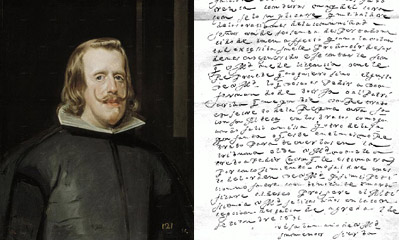
Philip IV had frequent correspondence with Mary of Agreda |
Thus began a long correspondence with the King that lasted for more than 20 years until her death on March 29, 1665. The more than 600 letters that survive to this day reveal the great trust the Spanish Monarch placed in the cloistered Abbess. He consulted her on both spiritual and temporal matters. (2) It was common for the King to write his questions on one side of the page, and for the Abbess to write her responses on the other side.
The letters reveal the pressing topics the King faced: Spain’s wars and quarrels with France, Flanders, Italy and Portugal, Catalonian rebellions and the lack of resources for his many initiatives. They also clearly show that Mother Mary of Jesus did not hesitate to remind him of his Catholic duties before God regarding his disordered personal life.
She wrote letters to Popes, Kings, Generals of Religious Orders, Bishops, nobles and every class of person in the Church and society. Although some have been lost, many survive, and we cannot help but admire the volume, extension, quality and variety of her epistolary activity. From her narrow cell, she truly touched the world of her time.
A controversial work on Our Lady
After her death in 1665, miracles and favors were reported, granted through her intercession. So well known was her extraordinary virtue that almost immediately the Spanish Bishops and other eminent churchmen took up the cause for her beatification. Eight years after her death, Maria de Jesus de Agreda was declared Venerable by Pope Clement X for her heroic practice of virtues.
Obstacles to her beatification, however, soon appeared in the form of objections to the Marial doctrine in The Mystical City of God, which had been published five years after her death and was received with great enthusiasm in Spain. The Spanish Inquisition scrutinized it for 14 years and found nothing contrary to Faith or Morals.
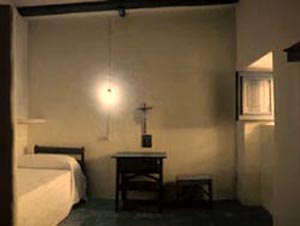
The cell of Mary of Agreda |
This was the golden marial age in Spain, and her Immaculate Conception was being fiercely debated. On one side as staunch defenders were the theologians who followed Duns Scotus, the Franciscans and the Spanish Universities of Salamanca, Madrid, Granada, among others. On the other side were the French Thomist theologians and, in particular, the University of the Sorbonne. In that climate of debate the work of Mother Mary of Agreda, which defends her Immaculate Conception, came under suspicion.
In 1681, the Holy Office censured the book, and on August 4 of the same year included it on the Index of Forbidden Books. By the order of Blessed Innocence XI, however, the decree of condemnation was removed three months later after it was shown that a faulty French translation was at the basis for the censure.
But the incident had a negative influence on her cause of beatification, and since then repeated campaigns have been made against The City of God. The Jansenists and Gallicans in the 18th century renewed the attack that the work was “excessive” in its devotion to Mary. Time and time again, the cause of Venerable Maria of Agreda was promoted, and then silenced.
In recent years, after the 400th anniversary of her birth in 2002, there have been renewed efforts by various Marian groups to move the beatification process forward. But another barrier stands in the way: the strong emphasis on Our Lady as Co-redemptrix and Co-mediatrix found in The City of God is in variance with the ecumenical doctrines of Vatican II. Mary of Agreda, once again, is being set aside for promoting devotion to Our Lady.
Incorrupt body
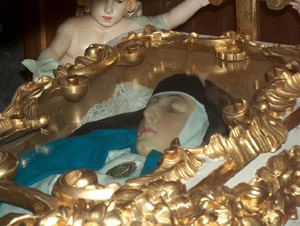
Her incorrupt body is displayed at the Convent Chapel |
The holiness and admirable life of Mother Mary of Jesus has never been disputed. Within the walls of the Conceptionist Convent of Agreda we find a lively memory of the venerable Abbess. There we can see the eight books of The Mystical City of God, her cell with its two windows and the Franciscan habit she wore. But the most extraordinary sight for the admiring pilgrim is the incorrupt body of Venerable Mother Mary of Jesus.
In 1909, her casket was opened for the first time after her death in 1665. Her body was found to be completely incorrupt. A full report on the condition of the body was prepared by physicians and authorities. In 1989, another careful scientific investigation was made. Spanish physician Andreas Medina reported that the body was in the same state as it was described in the medical report from 1909. “We realized it had absolutely not deteriorated at all in the last 80 years.”
It remains on display in the Convent Chapel of Agreda over which she had ruled for so many years. On the 400th anniversary of her death, over 12,000 pilgrims visited Agreda to venerate her and seek the intercession of the venerable Lady in Blue.
1. Translated by Fiscar Marison, 4 vols, (Chicago, 1916), Book I, pp. 19-20.
2. María de Jesús de Agreda: Correspondencia con Felipe IV, Religión y Razón de Estado, Introduction and notes by Consolación Baranda (Madrid: Editorial Castalia, 1991)
Continued

Posted March 24, 2010

Related Topics of Interest
 Mary of Agreda in America - Part I Mary of Agreda in America - Part I
 Mary of Agreda Describes Her Travels - Part II Mary of Agreda Describes Her Travels - Part II
 Mary of Agreda's Letter to the Missionaries in America Mary of Agreda's Letter to the Missionaries in America
 Testimonies of Mary of Agreda's Presence in the U.S. - Part III Testimonies of Mary of Agreda's Presence in the U.S. - Part III
 Catholicism in Colonial America Catholicism in Colonial America
 La Conquistadora: Our Country's Oldest Madonna La Conquistadora: Our Country's Oldest Madonna
 Ven. Antonio Margil of Jesus: Apostle of New Spain Ven. Antonio Margil of Jesus: Apostle of New Spain
 The First Expedition into the American Southwest The First Expedition into the American Southwest
 Pasquala of Mission Santa Ines Pasquala of Mission Santa Ines

Related Works of Interest
|
|
History | Home | Books | CDs | Search | Contact Us | Donate

© 2002-
Tradition in Action, Inc. All Rights Reserved
|
 |
|